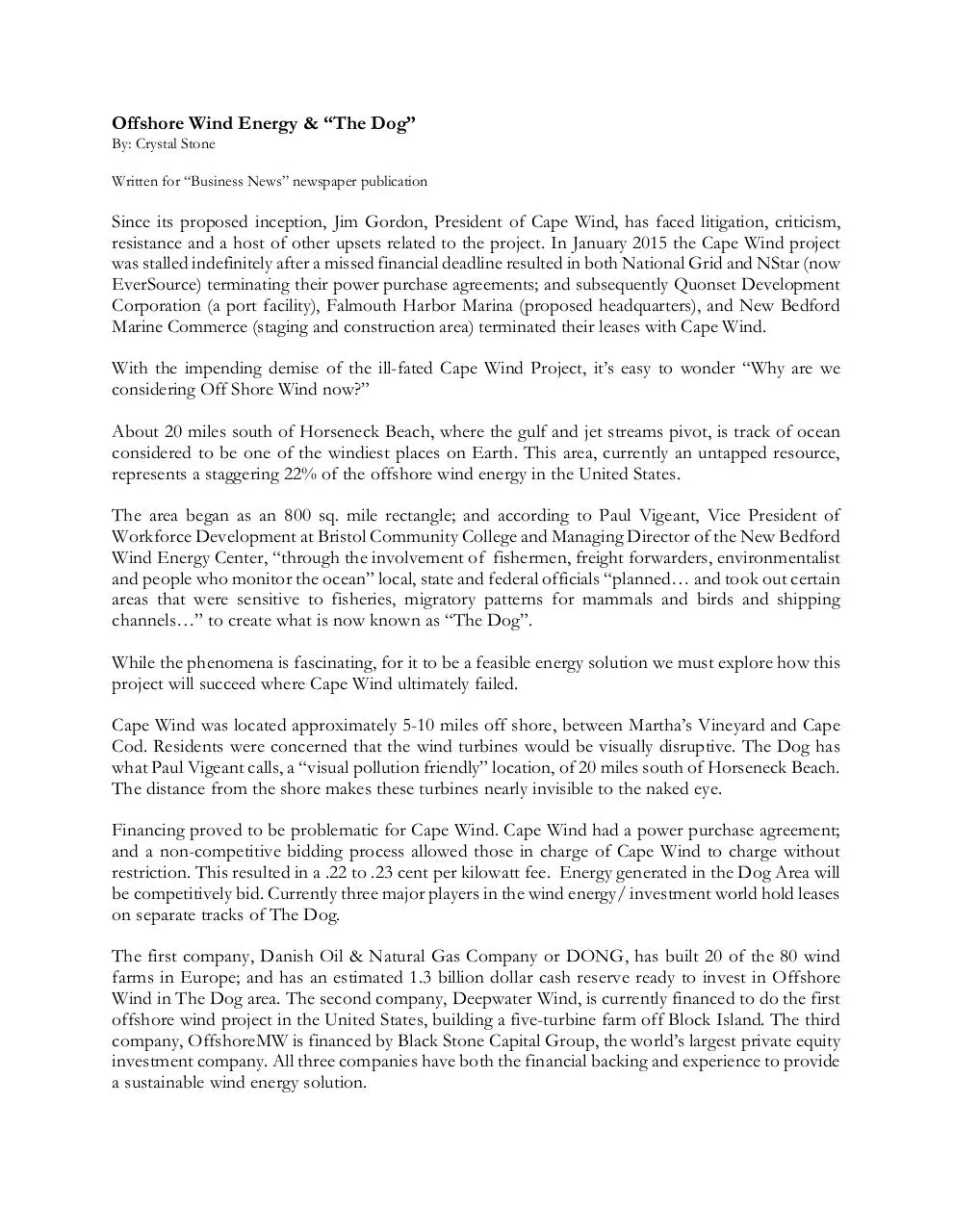THE DOG WIND ENERGY ESSAY FINAL (1) (PDF)
File information
Title: Microsoft Word - THE DOG WIND ENERGY ESSAY FINAL.docx
Author: CStone
This PDF 1.5 document has been generated by PScript5.dll Version 5.2.2 / Acrobat Distiller 10.1.16 (Windows), and has been sent on pdf-archive.com on 22/02/2019 at 12:40, from IP address 71.232.x.x.
The current document download page has been viewed 243 times.
File size: 67.83 KB (2 pages).
Privacy: public file


File preview
Offshore Wind Energy & “The Dog”
By: Crystal Stone
Written for “Business News” newspaper publication
Since its proposed inception, Jim Gordon, President of Cape Wind, has faced litigation, criticism,
resistance and a host of other upsets related to the project. In January 2015 the Cape Wind project
was stalled indefinitely after a missed financial deadline resulted in both National Grid and NStar (now
EverSource) terminating their power purchase agreements; and subsequently Quonset Development
Corporation (a port facility), Falmouth Harbor Marina (proposed headquarters), and New Bedford
Marine Commerce (staging and construction area) terminated their leases with Cape Wind.
With the impending demise of the ill-fated Cape Wind Project, it’s easy to wonder “Why are we
considering Off Shore Wind now?”
About 20 miles south of Horseneck Beach, where the gulf and jet streams pivot, is track of ocean
considered to be one of the windiest places on Earth. This area, currently an untapped resource,
represents a staggering 22% of the offshore wind energy in the United States.
The area began as an 800 sq. mile rectangle; and according to Paul Vigeant, Vice President of
Workforce Development at Bristol Community College and Managing Director of the New Bedford
Wind Energy Center, “through the involvement of fishermen, freight forwarders, environmentalist
and people who monitor the ocean” local, state and federal officials “planned… and took out certain
areas that were sensitive to fisheries, migratory patterns for mammals and birds and shipping
channels…” to create what is now known as “The Dog”.
While the phenomena is fascinating, for it to be a feasible energy solution we must explore how this
project will succeed where Cape Wind ultimately failed.
Cape Wind was located approximately 5-10 miles off shore, between Martha’s Vineyard and Cape
Cod. Residents were concerned that the wind turbines would be visually disruptive. The Dog has
what Paul Vigeant calls, a “visual pollution friendly” location, of 20 miles south of Horseneck Beach.
The distance from the shore makes these turbines nearly invisible to the naked eye.
Financing proved to be problematic for Cape Wind. Cape Wind had a power purchase agreement;
and a non-competitive bidding process allowed those in charge of Cape Wind to charge without
restriction. This resulted in a .22 to .23 cent per kilowatt fee. Energy generated in the Dog Area will
be competitively bid. Currently three major players in the wind energy/ investment world hold leases
on separate tracks of The Dog.
The first company, Danish Oil & Natural Gas Company or DONG, has built 20 of the 80 wind
farms in Europe; and has an estimated 1.3 billion dollar cash reserve ready to invest in Offshore
Wind in The Dog area. The second company, Deepwater Wind, is currently financed to do the first
offshore wind project in the United States, building a five-turbine farm off Block Island. The third
company, OffshoreMW is financed by Black Stone Capital Group, the world’s largest private equity
investment company. All three companies have both the financial backing and experience to provide
a sustainable wind energy solution.
The size of turbines to be used in the Cape Wind project are considerably smaller than those that
will be used for The Dog area. One hundred wind turbines with 1-2 megawatts size generators were
proposed for Cape Wind. In The Dog area approximately 200 wind towers, each with 8MW to
10MW turbines, will be created with “propellers as large as Fenway Park.” Wind farms on the federal
waters could “generate at least 10,000 megawatts, minimum,” says Representative Pat Haddad. With
a quantity and scale this large, The Department of Energy’s Wind Vision report forecasts that
offshore wind will achieve cost reductions of 22% by 2020, 43% by 2030, and 51% by 2050.
Additionally, New Bedford, MA has the first purposeful built port to service offshore wind.
Massachusetts recently invested 100 million dollars into this facility as a deployment port. “With
structures as large as seven story buildings these structures must be built in places with direct access
to shipping ports,” says Mr. Vigeant. Fall River and New Bedford are port facilities that are directly
accessible to The Dog.
Once the wind farm is created, companies looking to do business in the South Coast will be at the
forefront of an entire new industry. In addition to maintaining the wind farm, jobs in building,
manufacturing, transportation and a range of support services will be necessary. The European
industry created 75,000 wind energy related jobs by 2014 according to the European Wind Energy
Association.
Bristol Community College is preparing students for the many vocational needs of a wind farm. In
2004, the Engineering and Technology programs at Bristol Community College were tailored to
focus on advanced manufacturing. A Wind Engineering “certificate” track was created, and a
certificate program has been in existence for the past six years. Bristol Community College continues
to focus its efforts on meeting the needs of vocational career seekers in our community and
recognizes the need to be forward thinking. “Once you put the device in the ocean, they’re expected
to be there for 20 years,” and will require routine maintenance says Mr. Vigeant.
Representative Haddad has introduced a bill, which if passed, will dictate how much of
Massachusetts electricity will come from green power. Energy sources named in the bill include gas,
better access to Hydro-Quebec, land solar, land wind energy and 2,000 megawatts of shore wind.
Should this bill pass sometime between now and July production will start and about five years from
now we can expect these farms to be in production.
“With the highest cost for energy in the continental U.S., and 10,000 megawatts scheduled to be
decommissioned in four years, we need to begin filling the gap now,” says Rob Mellion, President
and CEO of the Fall River Area Chamber of Commerce. Offshore wind stands to be a key factor
in the diversified energy mix the South Coast needs.
Download THE DOG WIND ENERGY ESSAY FINAL (1)
THE DOG WIND ENERGY ESSAY FINAL (1).pdf (PDF, 67.83 KB)
Download PDF
Share this file on social networks
Link to this page
Permanent link
Use the permanent link to the download page to share your document on Facebook, Twitter, LinkedIn, or directly with a contact by e-Mail, Messenger, Whatsapp, Line..
Short link
Use the short link to share your document on Twitter or by text message (SMS)
HTML Code
Copy the following HTML code to share your document on a Website or Blog
QR Code to this page

This file has been shared publicly by a user of PDF Archive.
Document ID: 0001914420.